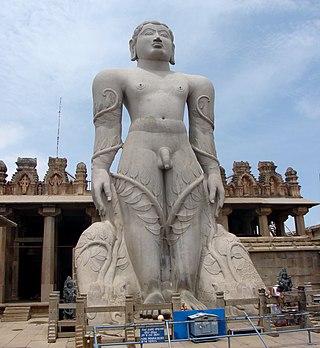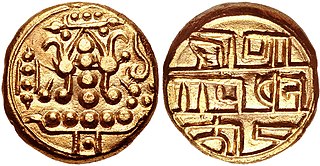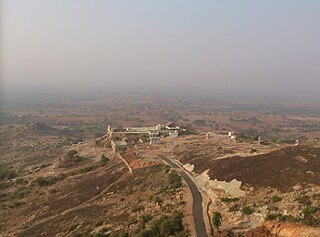
Halebidu is a town located in Hassan District, Karnataka, India. Historically known as Dwarasamudra, Halebidu became the regal capital of the Hoysala Empire in the 11th century CE. In the modern era literature it is sometimes referred to as Halebeedu or Halebid as the phonetic equivalent, a local name after it was damaged and deserted after being ransacked and looted twice by the forces of the Turko-Persian Delhi Sultanate in the 14th century.

Tulu Nadu or Tulunad is a region and a proposed state on the southwestern coast of India. The Tulu people, known as 'Tuluva', speakers of Tulu, a Dravidian language, are the preponderant ethnic group of this region. South Canara, an erstwhile district and a historical area, encompassing the undivided territory of the contemporary Dakshina Kannada and Udupi districts of Karnataka State and Kasaragod district of Kerala state forms the cultural area of the Tuluver.
The Bunt people are an Indian community who historically have inhabited the Tulu Nadu region in South India. Bunts were traditionally a warrior-class or martial caste community, with agrarian origins, forming the landed gentry of the region. They are the dominant land-owning, farming and banking community of Tulu Nadu and speak Tulu and Kundagannada as their mother tongue. Today, the Bunts are a largely urbanised community, with a population size of less than one million worldwide.

Humcha / Hombuja is a small town near Ripponpet, Hosanagara taluk in Shimoga district in the Indian state of Karnataka. Humbaja Atishaya Jain Teerth Kshetra is famous for being home to an ancient temple of Goddess Padmavati, and to the Humbaj Matha (seminary/monastery), an important institution of the Jain community. This temple is considered to be very holy and is known for its cultural and historical heritage. Other notable highlights of the place are a lake that reputedly never dries up and a tree that likewise always remains green.

Bahubali was the son of Rishabhanatha and the brother of the chakravartin Bharata. He is a revered figure in Jainism. He is said to have meditated motionless for 12 years in a standing posture (kayotsarga), with climbing plants having grown around his legs. After his 12 years of meditation, he is said to have attained omniscience.

Western Ganga was an important ruling dynasty of ancient Karnataka in India which lasted from about 350 to 1000 CE. They are known as "Western Gangas" to distinguish them from the Eastern Gangas who in later centuries ruled over Kalinga. The general belief is that the Western Gangas began their rule during a time when multiple native clans asserted their freedom due to the weakening of the Pallava empire in South India, a geo-political event sometimes attributed to the southern conquests of Samudra Gupta. The Western Ganga sovereignty lasted from about 350 to 550 CE, initially ruling from Kolar and later, moving their capital to Talakadu on the banks of the Kaveri River in modern Mysore district.

The Kalachuris of Kalyani, also Southern Kalachuris, were a 12th-century Indian dynasty, who ruled over parts of present-day northern Karnataka and Maharashtra. This dynasty rose to power in the Deccan region between 1156 and 1181 CE.
Ballal is a surname from coastal Karnataka in India. It is found among Shivalli Madhva Brahmins,Hindu Samantha Arasu, Bunt and Jain Royal communities.

The Alupa dynasty was an ancient ruling dynasty of India. The kingdom they ruled was known as Alvakheda Arusasira and its territory spanned the coastal districts of the modern Indian state known as Karnataka. The Alupas in their prime were an independent dynasty, centuries after reigning due to the dominance of Kadambas from Banavasi, they became feudatory to them. Later they became the vassals of the Chalukyas, Rashtrakutas, Hoysalas with the change in political scenario of Southern India. Their influence over coastal Karnataka lasted for about 1200 years. There is evidence that the Alupas followed the law of matrilineal inheritance (Appekatt/Aliyasantana) since the Alupa king Soyideva was succeeded by his nephew Kulasekhara Bankideva. The legendary king who is credited with introducing matrilineality in Alva Kheda|Tulu Vishaya Kheda is named Bhuta Alupa Pandya The descendants of this dynasty still survive to this date and have spread in the karavali region and they are widely referred to as the Bunt. The Bunts follow Matrilineality instead of the common Patrilineality, and are said to be Nagavanshi Kshatriyas by their maternal origin. They can be identified with their surnames such as Shetty, Rai, Hegde, Alva, Chowta etc. Even though most Bunt are Hindus by faith now, The sizeable section of the community still follows Jainism and they are called Jain Bunt The last Alupa king to have ruled is Kulasekharadeva Alupendradeva whose inscription dated 1444 CE have been found in Mudabidri Jain Basadi.

Venur or Venoor is a small village on the banks of the Phalguni river in Belthangady Taluk, Dakshina Kannada of Karnataka, India. It was once the seat of Jainism and the capital of the Ajila Dynasty. It is on the Dharmasthala-Moodabidri-Karkala route on the coastal religious circuit in the Karnataka State of India.
Chowta is a surname from coastal Karnataka in India. It is found among Jains& Bunts.

Karnataka, a state in South India has a long association with Jainism, a religion which enjoyed patronage of major historic kingdoms in the state such as the Rastrakuta Dynasty, Western Ganga, Kadamba and Chalukya dynasties and the Hoysala Empire. Today the state is home to a number of Jain monuments, such as temples, Gommata statues and stambhas.
The Western Ganga Dynasty ruled large parts of southern Karnataka from the fourth century CE till the late tenth century CE with their regal capital initially at Kolar and later at Talakad in Mysore district, Karnataka. The origin of the Ganga clan prior to the fourth century is shrouded in legends and myths. Clarity into their history comes from such contemporaneous writings as Chavundaraya Purana in Kannada and Lokhavibhaga in Prakrit and from numerous inscriptions excavated in the Mysore, Bangalore and Kolar districts and Anantapur district. The Western Gangas played a pivotal role in the development of polity, culture and literature during their long rule in the region, at times as independent monarchs and at other times as subordinates of their larger neighbors: the Badami Chalukyas and later the Rashtrakutas of Manyakheta. Their patronage to literature in Kannada and Sanskrit, their achievements in architecture including the famous monolith of Gomateshwara, their Hindu temples in the southern Karnataka, and their Jain Basadi's of Shravanabelagola and Kambadahalli are testimony to the rich contribution they made to the region.
Aladangady or Aladangadi is a small town in the Belthangady taluk of the Dakhina Kannada district in Karnataka, India located on the road connecting Guruvayanakere and Karkala.

Jainism has an extensive history in the Indian state of Tamil Nadu, although practiced by a minority of Tamils in contemporary times. According to the 2011 India Census, Jains represent 0.12% of the total population of Tamil Nadu, and are of the Digambara sect. Tamil Jains are primarily concentrated in northern Tamil Nadu, in the districts of Madurai, Viluppuram, Kanchipuram, Vellore, Tiruvannamalai, Cuddalore and Thanjavur.
Kalya (Kalavathi pattana) or Kalya is a historic settlement located in Magadi Taluk, Ramanagara district of Karnataka, India. Kalya as an early settlement can be attested by prehistoric rock art and tools reported from Kalya and inscriptional evidence in the village starting from 550 CE to the early 17th century CE, making it one of the few places in the country that has been continuously inhabited for 3000 to 3500 years.

Kanakagiri Jain tirth kshetra also known as Kanakadri and Hemantha Desha is situated at about 3 km from Maleyuru, Chamarajanagar district, 53 km from the Mysore city and 182 km from Bengaluru.
Banga Arasa or Banga Raja is the dynastic title of a medieval ruling family of coastal Karnataka, India. The word Banga is the name of a clan and a surname of the Bunts and the word Arasa or Raja means a ruler in the Tulu language. The dynasty followed the Bunt custom of matrilineal inheritance (Aliyasantana). The Banga Arasas claimed descent from the ancient Alupas and the rulers bore the Alupa royal title Pandyapparasa. The Banga Arasas were said to have been given control of 15 sub-divisions (Magane) of Southern Tulu Nadu by the Hoysala Ballal Emperor, Vira Narasimha. The Banga Arasas ruled from 1224 C.E until the conquest of South Canara by the British in 1799 CE. Descendants of the dynasty survive. However, the family seems to have stopped the coronation ritual after 1889 CE. Since the cessation of the coronation ritual no member of the family has borne the princely title Banga Arasa or Banga Raja instead preferring the aristocratic title Ballal. The dynasty patronized Jainism.They also built Hindu temples as well as shrines to deities of the Buta Kola folk tradition. Ullalthi, a form of the mother goddess worshiped in the Buta Kola tradition was the tutelary deity of the dynasty.

Santara or Bhairarasa was a medieval ruling dynasty of Karnataka, India. The area covered by their kingdom included territories in the Malenadu region as well as the coastal districts of Karnataka. Their kingdom had two capitals. Karkala in the coastal plains and Kalasa in the Western ghats. Hence the territory they ruled was also known as the Kalasa-Karkala kingdom. The Santaras were Jains and had matrimonial relations with the Saivite Alupa royal family. The Santaras became the feudatories of the Vijayanagara Empire after its rise. During this period, the Santara ruler Veera Pandya Bhairarasa erected the monolith of Bahubali in Karkala. The dynasty passed into oblivion after invasions by the Nayakas of Keladi and later by Hyder Ali.
The Chowta dynasty was a Jain dynasty that ruled parts of the Tulu Nadu region during the 12th – 18th centuries.












